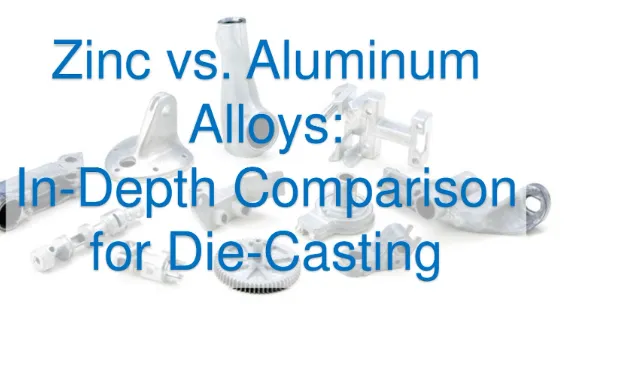Zinc vs Aluminum Alloys: In-Depth Comparison for Die-Casting

The die-casting manufacturing method is widely used for parts with complex geometries and incorporating favorable metal alloys. The process entails injecting molten metal into a mold to generate a part. Select materials are ideal for die-casting, including zinc and aluminum alloys.
The fluid nature and low melting point of zinc alloys is the perfect combination for die-casting. Aluminum also has inherent properties that suit the die-casting process. However, as with every material, zinc, and aluminum alloys present different specific properties in die-casting parts.
Also Read: UI/UX Design for Mobile Apps: Creating Experiences That Stick
Understanding the differences between zinc die casting vs aluminum die casting can help in selecting the perfect alloy for a project.
Read on to find out the properties that differentiate these two alloys.
What is zinc alloy?
Zinc alloy is mainly composed of zinc, with additional metal elements. Popular alloying elements are magnesium, copper, and aluminum. This alloy is manufactured by melting zinc and adding alloying elements in appropriate proportions.
The leading zinc alloys suitable for die-casting include ZAMAK 3 or Zinc Alloy 3. As the most common zinc alloy for zinc die casting applications, zinc alloy 3 has handy properties such as corrosion resistance and ductility. It is the ideal alloy for a part to be deformed after casting.
Another zinc alloy for casting is called ZAMAK 5 or Zinc Alloy 5. With a higher proportion of copper, this alloy is stronger and more corrosion-resistant.
There is also ZAMAK 7, zinc alloy 7. It is the purer of the other zinc alloys and contains magnesium at a lower percentage. Owing to this, the alloy is remarkably ductile and can produce highly intricate parts.
General properties of zinc alloy
- Low melting point
- Good casting capability
- High corrosion resistance
- Good surface finish
What is aluminum alloy?
Aluminum alloy is a name for aluminum-based alloys. These popular alloys can be grouped as casting alloys, wrought heat-treatable alloys, and wrought non-heat-treatable alloys. The main elements in these alloys include magnesium, zinc, copper, and manganese. There are other alloys in smaller proportions such as nickel and chromium.
Die-casting services providers take blocks of aluminum alloy and heat them. When these blocks melt, the manufacturers pour them into molds to achieve the desired shapes and sizes. The mold cavity is usually a combination of two halves of the envisaged final product.
When the mold is broken after the metal has solidified, the final product is revealed.
Aluminum alloy for die-casting is available in A380, A383, B390, and A360. Other types of aluminum alloy are A304 and A413 grades.
General properties of aluminum alloy
You want to consider the following properties when considering this alloy between zinc die casting vs aluminum die casting:
- Thermal conductivity
- Relatively high strength
- Can be heat treated for better corrosion resistance, strength, and so on
- Environmental friendly – recyclable
Differences between zinc alloy vs aluminum
Chemical and mechanical properties
Aluminum alloy has superior corrosion resistance, electrical conductivity, and thermal conductivity. Zinc alloys offer better wear resistance and mechanical properties. Their melting point is also low. The melting point of zinc is 420°C compared to 660°C for aluminum.
The corrosion resistance of zinc die-casting parts is higher than that of aluminum die-casting parts. Therefore, it would be better to use the zinc alloy parts in corrosive environments.
Material weight
Zinc alloys have a higher density than aluminum alloys. The specific gravities for zinc and aluminum are 5g/cm3 and 2.7g/cm3 respectively. The casting performance of zinc is excellent, and its strength can match some steels. Because of this property, aluminum alloy die-casting products are much lighter than zinc die-cast products.
Zinc alloy vs aluminum die-casting process
The fact that zinc melts at a lower temperature than aluminum translates to different die-casting process requirements. The parameters and setups used for the two alloys are different. While zinc alloy is die-cast in a hot chamber die-casting, aluminum alloy is processed through cold chamber die-casting equipment.
Since the die-casting processes for the two alloys are fundamentally different, the resulting properties of the products differ notably. For instance, zinc alloy die-casting parts are more durable than aluminum die-casting parts.
Longevity of die-casting tools
Regarding the abrasiveness of zinc vs aluminum alloys, zinc is less abrasive. This means that zinc alloys cause less damage to the molds, hence their tools last longer. Where aluminum molds provide 100,000 rounds, zinc molds can provide as much as 1,000, 000 rounds before the die-casting equipment requires replacement.
The overall cost of the die-casting process
Many factors are involved when comparing the cost of zinc vs aluminum alloys in die-casting. The most crucial considerations include the level of technical expertise, surface finishing requirements, type of material, and cycle time.
Post-processing steps can increase the cost, the same with a longer cycle time, and inadequate user skill. Typically, zinc alloy die-casting tends to be the more affordable process.
When to Choose Zinc Alloys
It is understandable to be stuck when choosing between zinc vs aluminum alloys. The following are pointers that zinc alloys would be better for the application:
Corrosive environments
Zinc die-casting parts perform better in tough environmental conditions. The protective layer on the surface of zinc die casting applications makes the material corrosion-resistant.
Thin-walled parts
Zinc alloy is stronger than aluminum alloy, so it is more suitable for thin-walled components. Its dense microstructure makes the structure of the part more reliable for more demanding applications. This aspect can also reduce the overall cost of the die-casting process.
Faster die-casting process
With a lower melting point, zinc alloy die-casting can be performed with a hot-chamber technique. The process is faster than the cold-chamber method, whereby the aluminum alloy has to be melted separately.
When to choose aluminum alloys
Similarly, there are instances when aluminum alloys are ideal for the die-casting parts. Consider the following points as a guide:
High electrical conductivity
Some die-casting parts must have high electrical conductivity for functional relevance. EMI shielding items are a good example because of the need to shield off electromagnetic signals.
High strength-to-weight ratio
Aluminum alloy die-casting parts are the best bet if the goal is high strength and low weight together. Aluminum alloy is among the best materials for blending these two characteristics as is evident from aluminium die casting applications. No wonder many aerospace and automotive die-casting components are built from aluminum alloy.
High working temperatures
If an application involves extreme temperatures, it is better to consider aluminium die casting applications. The material has a higher melting point, which would be safer for some applications.
In Conclusion
Understanding the differences, benefits, and applications of zinc vs aluminum alloys can help optimize projects involving die-casting parts. Both alloys have advantages that suit specific project types.
Aluminum has perfect electrical conductivity and strength-to-weight ratio while zinc is strong and impact-resistant. Considering all this, it is important to have a wholesome view of the cost, safety, durability, and functional requirements of the project.
Prolean Tech offers professional aluminum die-casting services, backed by expert design, manufacturing, and quality control processes. Call the team today to learn more.






